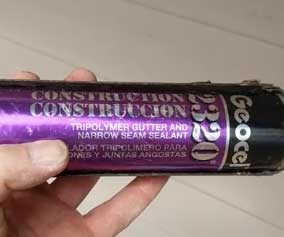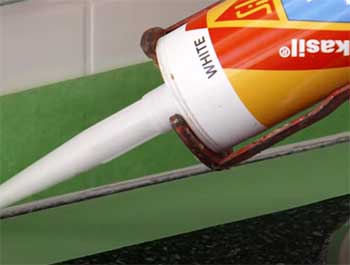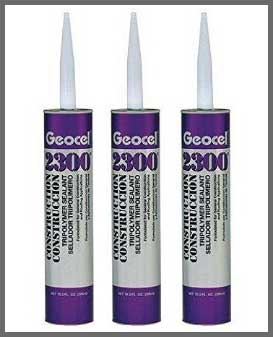Sealants play a crucial role in construction, manufacturing, and DIY projects by preventing leakage, protecting surfaces, and bonding materials together. Two of the most common sealant types are tripolymer sealants and silicone sealants.
But what exactly are they, and which one is better for specific applications?
This comprehensive guide examines the key differences, pros and cons, and ideal uses of tripolymer and silicone sealants.
A Brief Comparison Table
| Tripolymer Sealant | Silicone Sealant |
| Made from a blend of synthetic rubber polymers | Made from siloxane polymers derived from silicon and oxygen |
| More flexibility on porous surfaces like wood and concrete | More flexibility on non-porous surfaces like metal and plastic |
| Bonds well to damp and difficult to adhere to surfaces | Poor adhesion to porous or damp surfaces in some cases |
| More prone to UV damage over time outdoors | Superior UV and weather resistance |
| Can be painted over | Paint does not bond well to silicone |
| Lower temperature resistance, up to approximately 250°F | Heat resistance over 400°F |
| Emits some VOCs | Very low VOC content |
| Less water resistant for prolonged submersion | Better for watertight sealing |
What Is Tripolymer Sealant?
Tripolymer sealants, sometimes called tribopolymer or terpolymer sealants, are made from a combination of three different polymers – ethylene propylene diene monomer (EPDM), polyisobutylene (PIB), and butyl rubber. The exact formula and ratios vary between different brands and products.
Some key features and benefits of tripolymer sealants:

- Flexible and elastic – The blend of polymers creates a highly flexible and elastic sealant. This allows the sealant to expand and contract with materials as they move and shift, without cracking or losing adhesion.
- Excellent adhesion – Tripolymer sealants form a strong bond with many porous and non-porous surfaces like wood, concrete, metals, glass, and plastics. They adhere especially well to damp surfaces.
- Durable and long-lasting – Properly applied tripolymer sealant can last for decades outdoors exposed to sun, rain, snow and temperature extremes. It won’t crack, shrink or become brittle over time.
- Paintable – Many tripolymer sealants can be painted over after they fully cure. This allows them to blend in seamlessly on finished surfaces.
- Low-odor and low-VOC – Tripolymer sealants emit very little odor and volatile organic compounds (VOCs) compared to some other sealant types. This makes them better for indoor use.
- Resistant to fuels and oils – Tripolymer sealants maintain their integrity when exposed to automotive fluids like gasoline, diesel, and motor oils. This makes them ideal for sealing and repairing driveways, garages, and vehicle parts.
Common brand name tripolymer sealants include NP1 by Sika, Extreme Stretch by Loctite, and Quad by OSI. Overall, tripolymer sealants provide a highly versatile sealing solution for many DIY, construction, and industrial applications.
What Is Silicone Sealant?
Silicone sealants are made from siloxane polymers that are derived from silicon, oxygen, and other elements like carbon and hydrogen. The exact chemical composition varies between silicone types and grades.
Here are some of the notable features and advantages of silicone sealants:

- Highly flexible and elastic – Silicone can stretch and compress to over 50% of its size without damage. This makes it ideal for sealing surfaces and joints that experience a lot of movement.
- Excellent adhesion – Silicone bonds well to many non-porous surfaces including glass, metals, plastics, composites, and sealed woods. Some formulas also adhere to porous surfaces.
- Resists extreme temperatures – Silicone sealants stay rubbery and usable at temperatures from -60°F to more than 400°F. They are more heat resistant than many other sealants.
- UV and weather resistant – Silicone stands up very well to prolonged sun, rain, snow and temperature extremes without deteriorating.
- Low shrinkage – Silicone cures with very minimal shrinkage, reducing the chances of gaps forming after application.
- Watertight seal – Silicone provides an excellent watertight and airtight seal on windows, doors, siding, gutters, and more. It helps prevent drafts, moisture damage, and leaks.
- Chemical and corrosion resistant – Silicones resist oils, solvents, acids, and other chemicals that deteriorate other sealants. Their inert nature also resists corrosion.
Well-known silicone sealant brands include Dow Corning, GE Silicones, DAP Silicone, and Clear Seal silicone. Silicone sealants are suitable for many sealing jobs, but may not be ideal for all applications.
Applications Best Suited for Tripolymer Sealants
Thanks to their blend of durability, flexibility, and adhesion, tripolymer sealants excel in these applications:
- Sealing wood – Bonds extremely well to wood materials including dimensional lumber, plywood, OSB, and wood sidings. Effective for sealing joints in wood frames, windows, door frames, trim, and siding.
- Concrete and masonry sealing – Tripolymers adhere very well to concrete, natural stones, brick, block, and stucco. Useful for sealing control joints, cracks, and gaps. Also effective for bonding dissimilar masonry materials.
- Metal roof and gutter sealing – The flexibility and oil resistance suits tripolymer well for sealing metal roof panel seams, gutters, downspouts, ductwork, and HVAC components. It won’t become brittle or crack over time.
- RV and automotive sealing – For sealing fiberglass, painted metals, plastics, and rubber components on RVs, campers, and vehicles. Also suitable for windshield replacement. Handles vibration and expansion/contraction.
- Sealing damp surfaces – Tripolymer sealants can strongly bond to surfaces that are wet, icy, or contaminated where silicone will not adhere properly. This makes them ideal for exterior sealing projects in damp conditions.
- Porous surface repairs – Excellent for sealing and repairing defects in many porous building materials like stucco, concrete, wood, canvas, foam, and others.
- DIY and home repairs – An affordable and easy to use solution for typical household sealing tasks like windows, siding, trim, gutters, penetrations, ducts, and more.
Applications Best Suited for Silicone Sealants
Silicone sealants are unmatched for these specific uses:
- Glass and window sealing – Bonds very well to glass and other non-porous surfaces. Effective for sealing windows, skylights, mirrors, and glass blocks. Withstands sun, heat, and extreme cold.
- High temperature applications – Rated for prolonged heat exposure over 400°F. Ideal for sealing ovens, furnaces, boilers, exhaust systems, fireplaces, and other high heat sources.
- Watertight sealing – Provides an excellent waterproof seal for wet areas like bathrooms, sink perimeters, plumbing fixtures, tubs, and showers. Withstands prolonged water immersion.
- Food contact approved – Some silicone grades are FDA and NSF approved for sealing food prep and storage areas. Check sealant specs before use.
- Sensitive electronics – Non-corrosive nature allows use for sealing and protecting sensitive electronics. Often used in computers, phones, control panels, and more.
- Metal and plastic sealing – Creates very strong yet flexible seals on machined metals, powder coated metals, composites, and plastics. Withstands vibration, shock, and thermal expansion.
- Outdoor/marine applications – Superior UV resistance outperforms most other sealants outdoors long-term. Also effective for boats, buoys, and other marine uses.
- Unusual surfaces – Bonds well to difficult non-porous surfaces that tripolymer can struggle with like tile, ceramics, polycarbonate, and silicone rubber.
- Gas/vapor sealing – Low permeability helps silicone create gas and moisture proof seals around windows, ducting, lighting, electrical boxes, and displays cases.
Choosing The Right Sealant – Key Considerations
With all their differences, here are some key factors to consider when deciding between tripolymer and silicone sealants for a project:

- Surface material – Porous or non-porous? Masonry, wood and canvas favor tripolymer. Glass, plastic, and metal favor silicone.
- Exposure conditions – If exposed to extreme heat, cold, or UV, silicone is likely the better choice. Tripolymer handles milder climates well.
- Anticipated movement – The more expansion, contraction, vibration, or shock expected, the more silicone’s flexibility advantages it.
- Water immersion – For sealing areas that will be continually immersed in water, silicone is the better option.
- Appearance – If appearance matters, check sealant compatibility with surfaces, paints, and stains. Silicone often appears more glossy when cured.
- Indoor vs. outdoor use – Both work indoors, but silicone’s UV resistance gives it an advantage for exterior sealing tasks.
- Project size – For sealing very large areas, the lower cost of tripolymer sealant may prove more economical.
- Cure conditions – Silicone cures in a wider range of temperatures and humidity than tripolymer products.
Doing a small test application before any large project can help confirm adhesion, appearance, and suitability for the surfaces involved. When in doubt, consult the sealant manufacturer’s recommendations and surface preparation guidelines.
Silicone and Tripolymer Sealant – Frequently Asked Questions
For most applications, silicone is superior in overall performance and longevity compared to tripolymer and most other sealant types. However, tripolymer sealants do have advantages in certain situations detailed above.
Silicone sealants are derived from silicon-oxygen polymers while tripolymer sealants are a blend of synthetic rubber polymers. Main differences are the surface compatibility, temperature resistance, appearance, and cost.
Silicone is one specific type of sealant. The broader term “sealant” refers to any product designed to fill gaps and create leak-proof seals between materials. Many other sealant families exist besides silicone such as polyurethane, polysulfide, butyl, acrylic, and more.
For most sealing applications, silicone is superior to polyurethane. Silicone lasts longer outdoors, remains more flexible, has higher heat resistance, and adheres better to non-porous materials. Polyurethane costs less but doesn’t perform as well long-term.
Conclusion
Determining if a tripolymer or silicone sealant is the right choice depends on evaluating the substrates involved, the expected exposure conditions, anticipated movement, the desired appearance, and cost.
In general, silicone provides superior durability in extreme environments, excels at bonding non-porous materials, and creates watertight seals. Tripolymer sealants offer better performance sealing porous building materials like wood, concrete and masonry. They also provide a more economical option for large sealing projects.
Performing test applications and following manufacturer’s recommendations for surface prep and application is important to ensure adhesion and performance. Consider the sealant properties and your project details to decide which type suits your specific needs.

